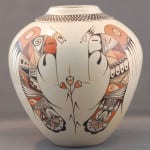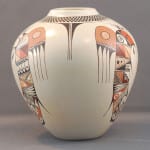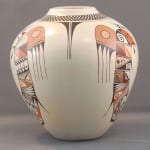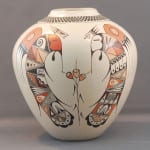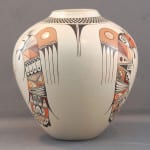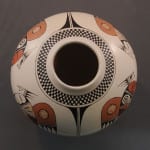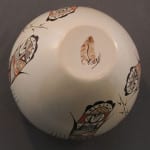This is an especially graceful vase that is both extraordinarily thin and well-formed, with an elegant polychromatic design that beautifully fits the form of the pot. “Graceful, extraordinary, elegant and beautiful”: you get the idea.
The design is a variation of a motif apparently developed by Annie Healing (2006-01) that has been adopted by other potters (2010-10). Two hummingbirds hover around a flower and drink its nectar.
Born in 1949, Rainy is the granddaughter of Paqua Naha—the first “Frog Woman,” and daughter of Helen Naha (“Feather Woman”). Generally, I prefer the fire-blushed look of much Hopi and Hopi-Tewa pottery and I am less attracted to the pure white egg-shell look of the pottery produced by the many potters of this family.
In the case of vase 2012-24, however, all that “graceful, elegant, and beautiful” work overwhelms my bias, and I fell in love.
The precise painting found on this jar often looks to me like a decal, and it lacks any of the spontaneous “folk art” look that I find so compelling of older Hopi pottery. Somehow, however, this jar cuts through all of my biases and presents itself as a gem of form and design. Aesthetic evaluation is not a logic process.
Concurrently with the purchase of this pot, the Heard Museum in Phoenix organized a show titled “Elegance from Earth” that focused on the Nampeyo, Naha, and Navaie families of Hopi. The show includes perhaps the finest Nampeyo pots I have ever seen, particularly an extraordinary bulbous Polik’Mana canteen by Nampeyo. Nevertheless, the Heard chose a vase by Rainy as the featured pot for their publicity and it’s hard to argue with their choice. (Copy of the Heard flyer is on file.)



